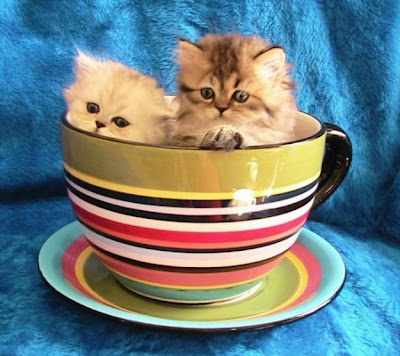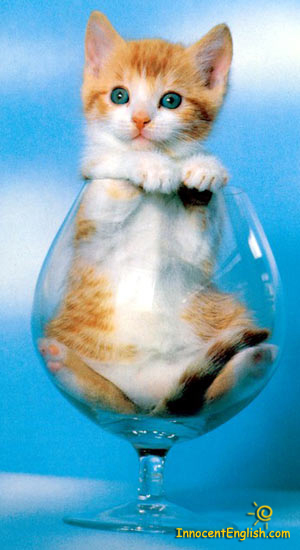Over the last 15 years, I have raised nine orphaned kittens. Four of them were two weeks old when their mother was killed; three others were only hours old when their mother died; two more kittens fell out of the nest in our barn when they were only a day old.
Raising motherless kittens is not a difficult process, but it does require patience, time and plenty of TLC.
Here are some tips to help you raise your orphaned kittens:
1. Make a nest.
Normally, a mother cat spends many hours a day in the nest with her kittens, which helps her babies stay warm. Keeping the kittens warm is important because if they're not warm enough, they won't want to eat, and in fact, all of their bodily functions will slow down.
To keep your orphaned kittens warm, make a nest in a small box and line it with towels or old t-shirts or sweatshirts to help the babies conserve their body heat. Put a towel over the box to keep out the light. Female cats choose nests that are dark. If you don't have a heat lamp, use a small 40-watt desk lamp and place it several feet above the box to help keep the kittens warm.
If the box is big enough, you can also use a jug or another large container filled with hot water to keep the babies warm. Place the jug in the box and then make a nest with towels beside it. Refill the jug when it cools off. You can use a quart jar as a "hot water bottle" too except that a quart jar cools off very quickly.
2. Use an eyedropper or a syringe to feed the kittens.
The first time I raised orphaned kittens, I discovered that the small nursing bottles available at vet clinics were too big. The kittens couldn't get their mouths around the nipples. So, at first, for newborn kittens, I used an eyedropper. As the kittens grew bigger, a syringe worked very well, the kind of syringe for giving injections (without the needle of course!). I started out with the 3 cc size and used larger syringes when the kittens grew bigger. The tip of a syringe is about the size of a cat's nipple, and my kittens eventually sucked hard enough on the end of the syringe to draw the plunger down by themselves. Check with your vet clinic to see if any used syringes are available or to see if you can buy new syringes from the clinic.
A word of caution: Whether you're feeding with an eyedropper or a syringe, be careful to give only a few drops at a time. My veterinarian told me that if the kittens were given too much formula at once (more than they could swallow), they might inhale it. Inhaling formula will make your kittens much more susceptible to pneumonia.
Along the way, I have also discovered that it is best to feed the kittens as much as they want to eat. They will settle down and sleep until the next feeding if they are getting enough to eat. Tiny kittens will start out taking maybe 1 CC at a time. As they grow bigger, they will eat around 12 CCs at a time (usually in several different helpings).
Kittens learn very quickly that food comes from the syringe you hold in your hand. If you are having trouble getting them to take the formula from the syringe, let nuzzle in the palm of your hand for a few seconds or let them suck on your fingers. Then introduce the syringe and let them suck on it while you very slowly press the plunger down.
3. Feed the kittens KMR or kitty formula that you have mixed yourself.
KMR, the canned cat milk replacer, is available at most vet clinics in either a premixed or dry form. It is specifically formulated for kittens to provide all the nutrients they need. Follow the directions on the label. The amount to feed is determined by body weight. My newborn kittens weighed three ounces each, and for the first several days, they only needed a half an eyedropper of KMR at a time.
My vet clinic also gave me a recipe for "kitten formula." After the first can of KMR, this is what all of my kittens have been raised on.
Here is the recipe for Kitten Formula
1 cup whole milk
1 tablespoon white corn syrup
1 egg yolk
a pinch of salt
Mix in a blender and mix it up far enough in advance so the bubbles will have time to dissipate.
Warm over medium heat. Heat the formula so it feels slightly warm to the touch. All of my kittens have refused to swallow the formula if it was too cold or too warm. The same was true for KMR.
4. Feed your kittens on a regular schedule three times a day.
Mother cats nurse their kittens every couple of hours. The veterinarian I consulted cautioned me not to feed them that often. "They won't eat well and you'll get frustrated and they'll get frustrated and it will be harder on everybody," he said. He was right. Feeding the kittens three times per day worked out very well.
5. Groom your kittens with a warm, wet washcloth and help them to empty their bladders and their bowels.
Young kittens are unable to empty their bladders or move their bowels, so you'll have to help them. Use a warm, wet washcloth and wipe under their tails until they have emptied their bladders and/or moved their bowels. Be prepared to use as many as four washcloths for each kitten. If they only have to empty their bladders, you won't need that many. If they have to empty their bowels, look out -- it could get messy! Smaller washcloths that you can wring out with one hand while you hold onto a squirming kitten with the other work best. I put the washcloths in a pail of warm water and put the pail where I can reach it easily.
Young kittens also do not know how to groom themselves, and after a day or two of eating kitten formula, they become sticky from the formula that inevitably dribbles down their chins. From time to time, use a warm, wet washcloth to wipe off the formula, but be careful not to get the kittens TOO wet or it will be hard for them to stay warm.
6. Provide a litter pan when they're four weeks old.
Cats have a strong instinct to use material that they can scratch around in when they have to empty their bladders and move their bowels. By the time the kittens are four weeks old, they will already be thinking in this direction and providing them with a litter pan will help them get the idea. You might still have to assist them with a washcloth for a while, but it won't be long before they are using the litter pan.
Kitty litter in an aluminum pie plate works well to start out. As the kittens grow bigger, use a bigger container for a litter box.
7. Start feeding solid food when the kittens are about six weeks old.
Kittens that are raised by their mothers probably will start eating sooner than six weeks, but you will be able to provide more milk than their mothers would have available.
When your kittens have gotten their teeth, you can begin feeding them solid food. If you want to feed dry food, a good quality kitten chow will work fine. Kitten chow has all of the nutrients and protein that they need to keep growing. Kitten chow also is made in tiny kitten-bite-sized pieces. To tempt their appetites and to give them a "treat," you can also try a little canned kitty food. Be sure to provide fresh water for your kittens to drink, as well. And until the kittens are eating solid food regularly, supplement their caloric intake with kitten formula. By this time, you won't have to feed them with a syringe. You can put the formula into a small saucer, and once they discover where it is and what it is, they will drink by themselves.
8. Be prepared to be surprised and amazed.
Kittens grow very quickly, and on some days, you will think they are growing right before your very eyes.
Kittens get their eyes open when they're about 10 days old.
They will start purring when they are as young as 6 days old.
Kittens will start other "kitty behaviors" such as shaking their heads, attempting to groom and lifting a hind food to scratch behind their ears when they are between two to three weeks old.
Young kittens will sometimes get the hiccups (!) while you are feeding them.
Young kittens are like baby humans, in a way. Their days consist of eating, sleeping and emptying their bowels and bladders. After the kittens have gotten enough to eat and have had their bodily functions taken care of, when you put them back in the "nest," they will sleep or rest quietly until you are ready to feed them again. If they are restless and crying and meowing, they might need a little more to eat, or they might have to empty their bladders or move their bowels, or they might feel cold.
As the kittens grow older, they will be awake for longer periods of time and will eventually start playing with each other.
By the time the kittens are four weeks old, you will most likely have to move them into a bigger box, if not sooner, because the first one will be too small and they will know how to get out on their own!






